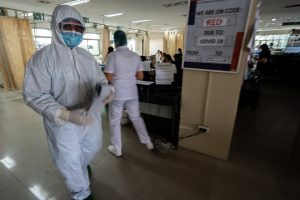The coronavirus pandemic is taking a turn for the worse in Southeast Asia. As total COVID-19 cases pass 30 million, and the world closes in on its millionth death from the contagion, a region once viewed as a success story is seeing persistent and accelerating infections in several nations, including the region’s two most populous.
In Indonesia, the Ministry of Health announced that September 17 saw a daily 3,963 new cases and 122 additional deaths, three days after authorities put the capital Jakarta into a second period of lockdown. This brought Indonesia’s total to 232,628 cases with a death toll of 9,222, the highest in the region.
Much of this can be put down to the threadbare, unscientific approach that the administration of President Joko “Jokowi” Widodo has taken to battling the contagion. In recent months, members of Jokowi’s cabinet have peddled a range of bogus cures for COVID-19, from prayer to mangosteen juice to necklaces made of eucalyptus leaves. At the same time, an August investigation by Reuters found that Indonesia’s rate of testing was among the world’s lowest, and that its contact tracing was minimal.
The lackluster response has put Jokowi’s administration at loggerheads with regional leaders who fear that the rising number of infections could overwhelm the nation’s under-resourced health system. In announcing the new lockdown measures in Jakarta, Governor Anies Baswedan warned that without the renewed restrictions, hospitals would soon reach full capacity in the capital, where new cases have averaged 1,000 per day over the past month. “There are not many options for Jakarta, except to pull the emergency brake as soon as possible,” Baswedan told a press conference.
At the same time, key officials have resisted lockdowns designed to contain the spread of the virus. At the beginning of September, Abdul Kadir, the director-general of Indonesia’s Ministry of Health, warned against reimposing a lockdown, saying it would push Indonesia into economic recession.
A similarly lackadaisical approach has been taken by the Philippines under President Rodrigo Duterte, which in mid-August overtook Indonesia as the worst-affected nation in Southeast Asia, in terms of total cases. On September 17, the Philippine health authorities announced 3,375 new coronavirus infections and 53 additional deaths, bringing these totals to 276,289 and 4,785, respectively. Local media reported today that 78 positive COVID-19 cases have so far been identified among staff at the nation’s parliament.
The other worrying case is Myanmar, which saw low community transmission until infections began to spiral upwards about a month ago. On September 18, the country’s health ministry announced 404 new cases along with 15 more COVID-19 linked deaths. The nation’s tallies now stand at 4,299 cases and 61 deaths, but military medics have predicted that 16,000 people could be infected with COVID-19 by the end of September if the virus continues spreading at its current rate.
The upsurge has coincided with the early phase of campaigning for Myanmar’s upcoming national election on November 8, prompting opposition parties to call for the polls to be postponed. The Union Election Commission ruled on September 14 that the election will go ahead as planned with COVID-19-related protocols in place – but that could conceivably change if things continue to worsen.
At the same time, Southeast Asia continues to provide some bright spots in the global fight against coronavirus. After a minor flare-up in late July and early August, Vietnam has reestablished control on the contagion. Where the Philippines has had more than 260,000 cases, Vietnam, which has a population roughly the same size, has reported just over 1,000. Infection rates continue to be low in Cambodia and Laos, while Thailand recently clocked up 100 days without a community infection, before an imported case ended its golden run earlier this month.

































